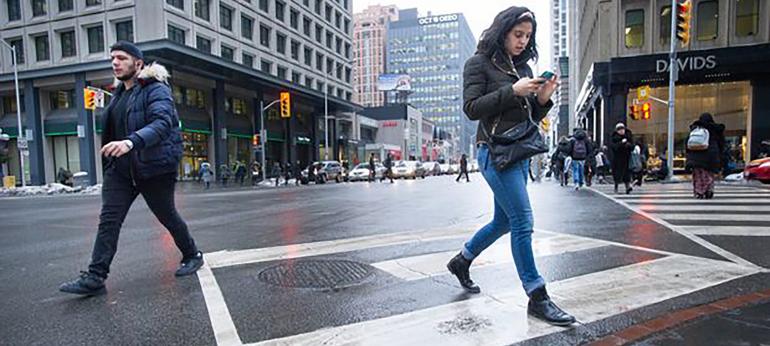
(Photo Credit: KEVIN VAN PAASSEN/THE GLOBE AND MAIL)
On Tuesday, February 12, 2019, The Globe and Mail hosted their second annual Globe Drive Mobility Summit, a half-day conference focused on the technology, innovations and societal shifts giving rise to the transformation of urban transportation.
One of the major topics for this year’s summit is how the growing trend of pedestrians being distracted by using their cellphones when walking in crosswalks, poses a danger for both pedestrians and vehicle road users. For urban planners the focus now is on how to measure and analyze these sidewalk dangers better and even prevent them.
In an article on February, 9, 2019, The Globe and Mail featured the research of UBC Civil Engineering Professor Tarek Sayed on pedestrian cellphone use.

In the UBC study, led by engineers, two cameras were mounted at pedestrian crossing intersections monitoring the movement of over 350 pedestrians over a two-day period. Observations from the study found that over a third of those who crossed the intersection were distracted by their phones while texting, reading, and talking. In turn, this distraction led to pedestrians crossing slower and moving unsteadily to the other side of the street.
In regards to how the data was collected, Professor Sayed wrote, “If we look at the distance walked and analyze their gait parameters, we can with about 80-per-cent accuracy determine who’s distracted and who’s not, which means that their walking behaviour is quite different.” And added, “we can quickly identify safety issues and come up with countermeasures much faster, in a matter of hours, than waiting three, four or five years to collect collision data.”
The ultimate goal in the current and research, and its subsequent implementation, is to look at safety measures that can be put in place, instead of faulting pedestrians versus drivers.
Sayed suggests that possible solutions could be to delay traffic lights at crosswalks to allow leeway for slower, distracted pedestrians. Additionally, the implementation of “scramble” crosswalks, where traffic in all directions stops and pedestrians have more space to cross, may allow for less incidents
Similar to the research and campaigns associated with distracted driving while using cellphones, the focus on distracted pedestrian cellphone use is more complex than just banning using cellphones while crossing the street. Safety measures need to be put in place to adjust to this growing trend, and in many cases this requires change in urban planning strategies around the city.
Detailed research findings and statistics are found in “Assessing the Effect of Pedestrians’ Use of Cell Phones on Their Walking Behavior: A Study Based on Automated Video Analysis,” which is available for download from the Transportation Research Record.
